Domestic oil production in the United States hit an all-time high of more than 13 million barrels per day this month for the first time in over three years, after plummeting during the early stages of the COVID-19 pandemic, according to the U.S. Department of Energy (DoE).
However, experts claim the bolstered production is a result of past policies.





